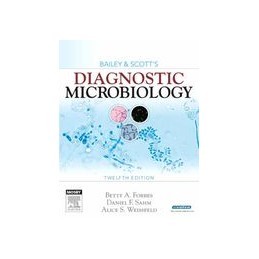Description
The new 12th edition of Bailey & Scotts Diagnostic Microbiology solidifies its reputation as the classic text in the field of microbiology. This new edition features the same comprehensive, authoritative content - and adds new and updated material throughout. The team of authors includes three well-respected clinical microbiologists, all of whom have experience both in the classroom and the clinical laboratory.
Product Details
Reference
30730
EAN13
9780323030656
ISBN
9780323030656
Data sheet
Publication date
2007
Issue number
12
Cover
hard cover
Pages count
1056
Dimensions (mm)
216 x 276
Weight (g)
2313
Part I: Basic Medical Microbiology Part II: General Principles in Clinical Microbiology Part III: Bacteriology NEW! NEW! Part IV: Parasitology Part V: Mycology Part VI: Virology Part VII: Diagnosis by Organ System Part VIII: Clinical Laboratory Management NEW! NEW! Appendix: Answers to Case Studies




 Delivery policy
Delivery policy
 Security policy
Security policy
 Return policy
Return policy
